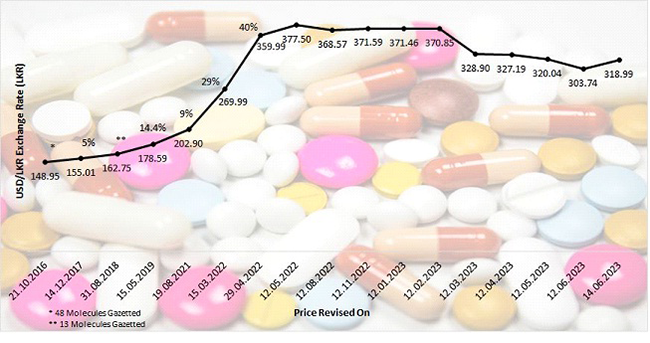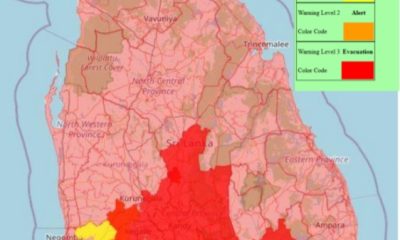Business
Clarification on current debate centred around the pricing of pharmaceuticals by SLCPI

The Sri Lanka Chamber of Pharmaceutical Industry (SLCPI) would like to provide the following clarifications to the general public on the ongoing debate and public discussion regarding the pricing of pharmaceuticals. There have been various misleading claims and misrepresentations made by various parties through both mainstream and social media on this subject. While some of these unfortunately are the result of ill-informed positions others are clearly politically motivated with mala fide intentions. Clearly an issue such as this needs attention but without bias and misinformation.
Therefore, we would like to provide the following clarifications in the wider interest of the general public.
Although it is being widely circulated that pharmaceuticals are governed by market forces and not price controlled, nothing can be further from the truth. Pharmaceuticals have been and remains the most rigidly price-controlled commodity in the market.
61 molecules are under gazetted price control where the maximum retail price is equivalent to the average price of all brands of the molecule. Other than these 61 molecules, all others have their initial price determined by the National Medicines Regulatory Authority (NMRA) where the price in the country of origin as well as the regional prices are considered in determining the final price. This price too is re-evaluated during the issuing of import licences every year and when registration is renewed every five years.
These 61 molecules cover more than 900 common generic/brands used to treat most chronic illnesses such as Diabetes, Heart Disease, Hypertension, and also most common Antibiotics.The 61 products where strict Gazetted Price Control is applied, account for approximately 35% of the most commonly consumed medicines according to independent IQVIA data.
With the introduction of price control with effect from 2016 ‘market forces’ no longer apply to pharmaceutical pricing.The government has allowed price increases of 5%, 14.4%, 9%, 29% and 40% respectively in order to counter the impact of the rapidly depreciating rupee. It must be noted that the final increase granted was in April 2022 and that was to bring parity when the USD was trading at Rs. 352. After that the dollar reached a peak of Rs. 372 and the pharmaceutical industry was not allowed to increase prices any further for a period of almost 10 months. The dollar deprecation only started in January 2023.
The current value of the dollar justifies a price decrease of 10% – 13% in pharmaceuticals when all factors are taken into account. This is the same price reduction the SLCPI proposed in writing to the Honourable Minister of Health. However, any price decrease at the present time must be with a proviso for a price increase if there is an appreciation of the dollar. In fact as per Central Bank data this has been happening in the last few days.
Any changes to the price of pharmaceuticals must factor in the expenses that are unique to the pharmaceutical industry such are cold chain maintenance, temperature controlling of warehouses, retail outlets and transportation. Most of these are highly sensitive to the cost of fuel and finance cost. Inordinate and haphazard delays in payments from the State Sector Agencies such as the SPC and MSD, have contributed to increased finance costs.
Although claims have been made that there have been 400% price increases in some pharmaceutical prices these remain unverified.The pharmaceutical industry has only increased prices by what has been permitted which is on average less than that of all other widely consumed commodities in the market.
For the sake of brevity, the SLCPI has listed out only the independently verifiable facts regarding the pricing of pharmaceutical products as it stands today.In conclusion, we take this opportunity to outline the only possible solution which will ensure an uninterrupted and uniform supply of high-quality pharmaceuticals to the general public.
Sri Lanka is in need of a transparent, equitable and fair pricing mechanism that is applicable to all pharmaceuticals. This has been an ongoing call to action by the SLCPI, and it has now been referred to the Court of Appeal of the country. Such a mechanism cannot be formulated by the State alone but must involve all stakeholders and be consistent with the stipulations of National Medicinal Drugs Authority Act No 5 of 2015. It would be ill advised and counterproductive in the long term for any one party, be it the government, the health care services, trade unions, religious leaders or even the pharmaceutical industry itself to be allowed to dictate the pricing of pharmaceuticals in a unilateral and /or random manner.
The implementation of a pricing mechanism is the only way to ensure the uninterrupted supply of high-quality pharmaceuticals at a fair and equitable price to the general public.
Business
ADB approves support to strengthen power sector reforms in Sri Lanka

The Asian Development Bank (ADB) has approved a $100 million policy-based loan to further support Sri Lanka in strengthening its power sector. This financing builds on earlier initiatives to establish a more stable and financially sustainable power sector.
This second subprogram of ADB’s Power Sector Reforms and Financial Sustainability Program will accelerate the unbundling of the Ceylon Electricity Board (CEB) into independent successor companies for generation, transmission, system operation, and distribution, as mandated by the Electricity Act of 2024 and its 2025 amendment. The phased approach ensures a structured transition, ensuring progress in reform actions and prioritizing financial sustainability.
“Sri Lanka has made important progress in stabilizing its economy and strengthening its fiscal position. A well-functioning power sector is vital for the country’s continued recovery and sustainable growth,” said ADB Country Director for Sri Lanka Takafumi Kadono. “ADB is committed to supporting Sri Lanka’s long-term development and advancing key reforms in the power sector. This initiative will enhance power sector governance, foster private sector participation, and accelerate renewable energy development to drive sustainable recovery, resilience, and inclusive growth.”
To improve financial sustainability, the program will help implement cost-reflective tariffs and a comprehensive debt restructuring plan for the CEB. It will support the new independent successor companies in transparent allocation of existing debts. This will continue to strengthen their financial viability, enhance creditworthiness, and enable these companies to operate on a more sustainable footing.
The program also aims to strengthen renewable energy development and private sector participation by enhancing transparency and supporting power sector entities that are financially sustainable. It will enable competitive procurement for large-scale renewable energy projects and identified priority generation schemes, while upholding strong environmental standards.
Promoting gender equality and social inclusion is integral to the program. Energy sector agencies have implemented annual women’s leadership programs, adopted inclusive policies, and launched feedback mechanisms to ensure equitable participation of female consumers and entrepreneurs. The program includes targeted support for vulnerable groups, such as maintaining lifeline tariffs and implementing measures to soften the impact of tariff adjustments and sector reforms.
ADB will provide an additional $2.5 million technical assistance grant from its Technical Assistance Special Fund to support program implementation, build the capacity of successor companies, and help develop their business plans and power system development plans.
Business
Union Assurance becomes first insurer to earn the YouTube Silver Play Button

Union Assurance, Sri Lanka’s longest-standing private Life Insurer, has achieved a milestone in its digitalisation journey by being awarded the YouTube Silver Play Button, recognising the Company for surpassing 100,000 subscribers on its official channel. This achievement marks a first in Sri Lanka’s Insurance industry, across both Life and General Insurance, and underscores Union Assurance’s pioneering role in digital engagement.
This accomplishment reflects the Company’s unwavering commitment to making Life Insurance accessible, simplified, and engaging for all Sri Lankans. Through innovative content strategies, Union Assurance has successfully transformed complex Insurance concepts into relatable, informative, and inspiring narratives that empower individuals to protect what matters most; health, wealth, family, and future.
Receiving the Silver Play Button is more than a symbolic accolade; it is a testament to the strength and credibility of Union Assurance’s digital presence. In an era where trust and transparency define brand loyalty, this recognition validates the company’s ability to create content that resonates deeply with a growing audience. It enhances the brand’s authority, reinforces its visibility across digital platforms, and further solidifies Union Assurance as a leader in customer engagement.
Celebrating this achievement, Mahen Gunarathna, the Chief Marketing Officer at Union Assurance stated: “This milestone is a testament to the trust and engagement of our audience and reflects our dedication to innovation, transparency, and customer-centric communication.
Business
LOLC Finance Factoring powers business growth

LOLC Finance PLC, the largest non-banking financial institution in Sri Lanka, brings to light the significant role of its Factoring Business Unit in providing indispensable financial solutions to businesses across the country. With a robust network of over 200 branches, LOLC Finance Factoring offers distinctive support to enterprises, ranging from small-scale entrepreneurs to corporate giants.
In light of the recent economic challenges, LOLC Finance Factoring emerged as a lifeline for most businesses, ensuring continuous liquidity to navigate through turbulent times. By facilitating seamless transactions through online platforms and expediting payments, the company played a pivotal role in sustaining essential services, including supermarkets and pharmaceuticals.
Deepamalie Abhaywardane, Head of Factoring at LOLC Finance PLC, emphasized the increasing relevance of factoring in today’s economy. “As economic conditions become more stringent, factoring emerges as the most sought-after financial product for businesses across various sectors. It offers a win-win solution by providing upfront cash up to 85% of the credit sale to suppliers while allowing end-users/buyers better settlement period.”
One of the standout features of LOLC Finance Factoring is its hassle-free application process. Unlike traditional bank loans that require collateral, LOLC Factoring extends credit facilities without such obligations. Furthermore, LOLC Finance Factoring relieves business entities of the burden of receivable management and debt collection. Through nominal service fees, businesses can outsource these tasks, allowing them to focus on core operations while ensuring efficient cash flow management.
For businesses seeking Shariah-compliant factoring solutions, LOLC Al-Falaah’s Wakalah Future-Cash Today offers an efficient and participatory financing model that meets both financial needs and ethical principles. Understanding the diverse challenges faced by businesses, LOLC Finance Factoring deliver tailored solutions that enhance cash flow, reduce credit risk, and support sustainable growth. Working together with LOLC Al-Falaah ensures access to a transparent, well-structured receivable management solution strengthened by the credibility and trust of Sri Lanka’s largest NBFI, LOLC Finance.
The clientele of LOLC Finance Factoring spans into various industries, including manufacturing, trading, transportation, healthcare, textiles, plantations, and other services, all contributing significantly to Sri Lanka’s economic growth. By empowering businesses with accessible and convenient working capital solutions, LOLC Finance’s Factoring arm plays a vital role in fostering economic development and prosperity of the country.
In the upcoming quarter, LOLC Finance Factoring remains committed to delivering innovative financial solutions tailored to meet the evolving needs of businesses. As Sri Lanka’s economic landscape continues to develop, LOLC Finance Factoring stands ready to support enterprises on their journey towards growth and success.
-

 News6 days ago
News6 days agoWeather disasters: Sri Lanka flooded by policy blunders, weak enforcement and environmental crime – Climate Expert
-

 Latest News7 days ago
Latest News7 days agoLevel I landslide RED warnings issued to the districts of Badulla, Colombo, Gampaha, Kalutara, Kandy, Kegalle, Kurnegala, Natale, Monaragala, Nuwara Eliya and Ratnapura
-
News3 days ago
Lunuwila tragedy not caused by those videoing Bell 212: SLAF
-

 Latest News7 days ago
Latest News7 days agoINS VIKRANT deploys helicopters for disaster relief operations
-

 News2 days ago
News2 days agoLevel III landslide early warning continue to be in force in the districts of Kandy, Kegalle, Kurunegala and Matale
-

 Latest News5 days ago
Latest News5 days agoLevel III landslide early warnings issued to the districts of Badulla, Kandy, Kegalle, Kurunegala, Matale and Nuwara-Eliya
-

 Features4 days ago
Features4 days agoDitwah: An unusual cyclone
-

 Latest News5 days ago
Latest News5 days agoUpdated Payment Instructions for Disaster Relief Contributions





















